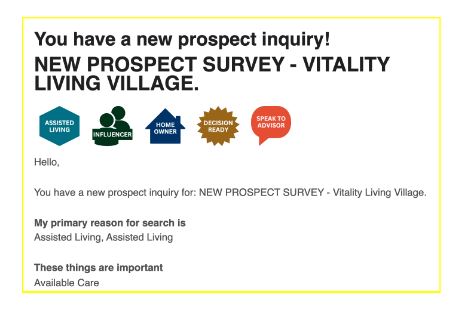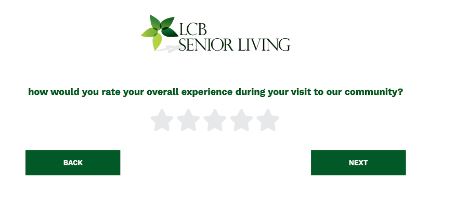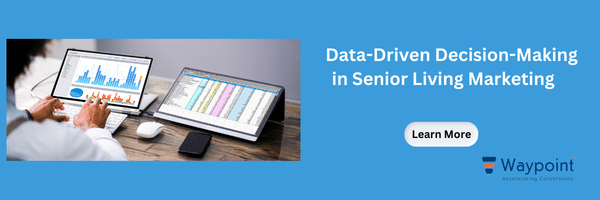
If you have watched any of my webinars or listened to any of my podcasts before, you know that I love sales.
I do!
It’s been a passion of mine for over 30 years and still going strong. I thrive on the personal interaction critical in the sales process no matter what vertical you work in.
People buy from people that they like and trust, not faceless technology.
But I would also be naive to say that sometimes, a little help from technology can’t hurt; it can benefit the sales process.
Take survey technology in senior living marketing, for example. This technology is extremely powerful and has many benefits, such as a more accurate ability to qualify high-intent leads, personalization, and data-driven decision-making.
Let’s take a look at the eight advantages of utilizing survey technology in senior living marketing:
1. Value-Based Selling
One of the most significant benefits of survey technology is its ability to support value-based selling. By collecting data directly from potential residents and their families, marketers and sales professionals can better understand what matters most to them—whether it’s team tenure, quality of care, community amenities, wellness programs, or social engagement opportunities. With this information, marketing and sales can tailor their messaging to highlight the values that align with their audience’s priorities, making their offerings more compelling and relevant.
So what exactly does value-based selling in the senior living space look like?
Well, I’m glad you asked!
Keep reading for specific examples of value-based selling in the senior living space.
2. Targeted Marketing
Survey technology allows senior living communities to segment their audience based on demographics, preferences, and behaviors. By understanding the unique needs of different segments, marketers can create targeted campaigns that speak directly to each group’s concerns and desires.
For example, a survey might reveal that one segment values wellness programs while another is more interested in dining options. By gathering detailed information about prospective residents’ preferences, such as desired amenities, care levels, and lifestyle choices, you can tailor your messaging to resonate with their needs.
This targeted approach improves engagement and increases the likelihood of conversions. According to the Direct Marketing Association, segmented, targeted, and personalized emails generate 58% of all revenue attributed to email marketing.
With this knowledge, marketers can craft personalized messages that resonate with each group, leveraging marketing automation, and leading to more effective and efficient marketing efforts.
3. Improved Lead Generation
Effective lead generation is the lifeblood of any marketing strategy, and survey technology can significantly enhance this process. By using surveys to qualify leads, marketers can identify prospects most likely to convert into residents. For instance, a survey might ask potential residents about their timeline for moving, budget, home ownership, and preferred amenities. With this data, marketers can prioritize leads that fit the community’s offerings, ensuring their sales efforts focus on the most promising prospects.
Additionally, survey data can be used to create personalized lead nurturing campaigns, which provide potential residents with relevant information and address their specific concerns. According to Forrester Research, companies that excel at lead nurturing generate 50% more sales-ready leads at a 33% lower cost.
Gamifying the Lead Generation Process in Senior Living
Collecting data is just part of the process; the real success lies in what you do with this data.
Waypoint Converts has developed a system that allows us to gamify the lead-generation process with our email badges.
When a new prospect fills out a survey, their information is processed, and they are then assigned email badges based on their responses. These badges are sent to the sales team as part of the new prospect inquiry, and the beauty of these badges is that they immediately help to tell a deeper story about the prospect’s intent.
This information is invaluable to the sales team because it provides them with specific data points about the prospect, allowing them to tailor their follow-up and create a more personalized experience for the prospect.

4. Enhanced Customer Satisfaction
As a salesperson, I know how easy it is to get tunnel vision on the sales process and forget about the post-sale journey.
However, as an entrepreneur and a CEO, I know that closing the sale is just the first step in the customer journey. To sustain your business, you must focus on customer satisfaction and what happens post-sale.
And a little extra effort in the post-sale customer journey can pay HUGE dividends.
A report by Frederick Reichheld of Bain & Company found that increasing customer retention rates by 5% increases profits by 25% to 95%.
Imagine what a mere 5% increase in customer retention can do for your business.
Customer satisfaction is not just about meeting expectations; it’s about exceeding them. Survey technology enables senior living communities to gather ongoing feedback from prospects and residents alike, allowing them to refine their offerings and address any concerns promptly. This proactive approach to customer satisfaction can lead to higher trust and loyalty, which can drive positive word-of-mouth referrals and strengthen the community’s reputation in the market.
Leveraging survey technology in the prospect process for pre- and post-tours can be extraordinarily impactful in improving and meeting prospects where they are.

5. Data-Driven Decision Making
In the age of digital marketing, data is king. Survey technology provides marketers with a wealth of data that can be used to inform decision-making at every stage of the marketing funnel. Whether optimizing ad campaigns, refining messaging, or identifying new market opportunities, survey insights can guide marketers in making informed, data-driven decisions that maximize ROI. This analytical approach ensures that marketing efforts are not based on guesswork but on real-world data that reflects the needs and preferences of the target audience.
For example, you can leverage this data and feedback to build content you currently don’t offer, addressing consumers’ questions even earlier in the search process.
6. Cost-Effective Marketing
Marketing budgets are always a consideration, and survey technology offers a cost-effective solution for gathering insights and optimizing strategies. Traditional market research methods can be expensive and time-consuming, but digital surveys provide a more affordable and scalable alternative. By leveraging survey technology, senior living marketers can quickly and efficiently gather the information they need to refine their strategies without breaking the bank. This cost-effectiveness allows for more agile marketing, where adjustments can be made on the fly based on real-time feedback.
Not to mention capturing leads on your website before a third-party lead aggregator captures them.
7. Personalization
Today’s consumers expect personalized experiences, and survey technology makes it easier for senior living marketers to deliver on this expectation.
According to a report, 80% of consumers are more likely to purchase from a brand that provides personalized experiences.
By collecting detailed information about prospects’ preferences, needs, and concerns, marketers can create highly personalized marketing campaigns that resonate on an individual level. Personalization can be as simple as addressing specific concerns in email campaigns or as complex as developing custom content that speaks directly to a prospect’s unique situation. This level of personalization improves engagement and increases the likelihood of conversion.
I have the numbers to back it up.90% of United States consumers find marketing personalization very or somewhat appealing, according to Statista.
8. Anxiety Reduction
Making the decision to move from a private residence to a senior care facility can be stressful, and it’s our job as senior living professionals to help reduce the anxiety surrounding this life experience.
While the human connection in the sales process remains important, data shows that more prospects are conducting their research online.
One report shows that 80% of research is done online.
- 90% of these online researchers are looking for financial information and resources
- 50%+ relate their search experience with feeling worried, fearful and full of anxiety
- 10% have confidence in the quality of information online

Survey technology can play a crucial role in reducing this anxiety by offering a platform for clear communication and transparency. By gathering detailed feedback on concerns, preferences, and expectations, senior living communities can address potential issues before they escalate, provide personalized information that eases worries, and ensure that residents feel heard and understood. This proactive approach helps to build trust and reassurance, making the decision-making process smoother and more comfortable for everyone involved.
Examples of Value-Based Selling in Senior Living
As promised above, I wanted to share some specific tactics for value-based selling in senior living.
Value-based selling in senior living focuses on highlighting your community’s unique benefits and intangible advantages rather than solely focusing on price or amenities. Here are some examples:
Highlighting Community Culture and Lifestyle
- Showcase social events and activities: Emphasize the vibrant community atmosphere and the opportunities for residents to connect with others through social events, clubs, and activities.
- Highlight personalized wellness and care: Demonstrate how your community provides individualized care plans and support services that meet each resident’s unique needs.
- Showcase the community’s location and amenities: Highlight the benefits of the community’s location, such as proximity to amenities, transportation options, and natural beauty.
Emphasizing Peace of Mind and Security
- Highlight safety features: Discuss the security measures in place, such as 24/7 surveillance, emergency call systems, and staff availability.
- Emphasize the peace of mind that comes with living in a senior living community: Discuss the benefits of having a supportive community and the peace of mind that comes with knowing that assistance is available when needed.
Focusing on Quality of Life
- Highlight the benefits of a healthy lifestyle: Discuss the community’s commitment to promoting a healthy lifestyle through wellness programs, nutritious meals, and fitness facilities.
- Showcase the community’s commitment to resident well-being: Emphasize the community’s focus on providing a comfortable, enjoyable, and fulfilling living experience.
Demonstrating Value Through Testimonials
- Share testimonials from current residents: Highlight the positive experiences of residents and their families, emphasizing the value they have received from living in your community.
Focusing on the intangible benefits of your senior living community can help you differentiate yourself from competitors and attract residents who are looking for more than just a place to live.
Conclusion
In conclusion, survey technology is an invaluable tool for senior living marketers. By leveraging survey data, you can create more targeted and effective marketing campaigns, improve customer satisfaction, and make data-driven decisions. Incorporating survey technology into your marketing strategy can help you stand out in a competitive market and attract the right residents to your community.

